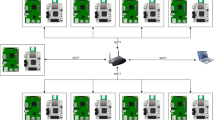Abstract
We propose a framework for utilizing fixed ultra-wideband ranging radio nodes to track a moving target radio node in an environment without guaranteed line of sight or accurate odometry. For the case where the fixed nodes’ locations are known, we derive a Bayesian room-level tracking method that takes advantage of the structural characteristics of the environment to ensure robustness to noise. For the case of unknown fixed node locations, we present a two-step approach that first reconstructs the target node’s path using Gaussian Process Latent Variable models (GPLVMs) and then uses that path to determine the locations of the fixed nodes. We present experiments verifying our algorithm in an office environment, and we compare our results to those generated by online and batch SLAM methods, as well as odometry mapping. Our algorithm is successful at tracking a moving target node without odometry and mapping the locations of fixed nodes using radio ranging data that are both noisy and intermittent.
Similar content being viewed by others
References
Djugash, J., Singh, S., Kantor, G., & Zhang, W. (2006). Range-only SLAM for robots operating cooperatively with sensor networks. In Proc. IEEE int. conf. robotics and automation.
Djugash, J., Singh, S., & Grocholsky, B. (2008). Decentralized mapping of robot-aided sensor networks. In Proc. IEEE int. conf. robotics and automation.
Ferris, B., Hahnel, D., & Fox, D. (2006). Gaussian processes for signal strength-based location estimation. In Proc. robotics: science and systems conf.
Ferris, B., Fox, D., & Lawrence, N. D. (2007). WiFi-SLAM using Gaussian process latent variable models. In Proc. int. joint conf. artificial intelligence.
Gezici, S., Thian, Z., Giannakis, G. B., Kobayashi, H., Molisch, A. F., Poor, H. V., & Sahinoglu, Z. (2005). Localization via ultra-wideband radios. IEEE Signal Processing Magazine, 22(4), 70–84.
Grisetti, G., Kuemmerle, R., Stachniss, C., Frese, U., & Hertzberg, C. (2010). Hierarchical optimization on manifolds for online 2D and 3D mapping. In Proc. IEEE int. conf. robotics and automation.
Gustafsson, F., & Gunnarsson, F. (2005). Mobile positioning using wireless networks. IEEE Signal Processing Magazine, 22(4), 41–53.
Hollinger, G., Djugash, J., & Singh, S. (2008). Tracking a moving target in cluttered environments with ranging radios. In Proc. IEEE int. conf. robotics and automation.
Hollinger, G., Singh, S., Djugash, J., & Kehagias, A. (2009). Efficient multi-robot search for a moving target. The International Journal of Robotics Research, 28(2), 201–219.
Hu, L., & Evans, D. (2004). Localization for mobile sensor networks. In Proc. int. conf. mobile computing and networking.
Kaess, M., Ranganathan, A., & Dellaert, F. (2008). iSAM: Incremental smoothing and mapping. IEEE Transactions on Robotics, 24(6), 1365–1378.
Kehagias, A., Djugash, J., & Singh, S. (2006). Range-only SLAM with interpolated range data. Technical Report CMU-RI-TR-06-26, Robotics Institute, Carnegie Mellon Univ.
Ko, J., & Fox, D. (2011). Learning GP-Bayes filters via Gaussian process latent variable models. Autonomous Robots, 30(1), 3–23.
Kuhn, M., Zhang, C., Mahfouz, M., & Fathy, A. E. (2009). Real-time UWB indoor positioning system with millimeter 3-D dynamic accuracy. In IEEE antennas and propagation society int. symp.
Kumar, V., Rus, D., & Singh, S. (2004). Robot and sensor networks for first responders. IEEE Pervasive Computing, 3(4), 24–33.
Lawrence, N. D. (2005). Probabilistic non-linear principal component analysis with Gaussian process latent variable models. Journal of Machine Learning Research, 6, 1783–1816.
Liao, E., Hollinger, G., Djugash, J., & Singh, S. (2006). Preliminary results in tracking mobile targets using range sensors from multiple robots. In Proc. int. symp. distributed autonomous robotic systems.
Mullane, J., Adams, M. D., & Wijesoma, W. S. (2009). Robotic mapping using measurement likelihood filtering. The International Journal of Robotics Research, 28(2), 172–190.
Multispectral Solutions, Inc. (2008). Company website. http://www.multispectral.com/.
Nicoli, M., Morelli, C., & Rampa, V. (2008). A jump Markov particle filter for localization of moving terminals in multipath indoor scenarios. IEEE Transactions on Signal Processing, 56(8), 3801–3809.
Olson, E., Leonard, J. J., & Teller, S. (2006). Robust range-only beacon localization. IEEE Journal of Oceanic Engineering, 31(4), 949–958.
Priyantha, N. B., Balakrishnan, H., Demaine, E., & Teller, S. (2005). Mobile-assisted localization in wireless sensor networks. In Proc. IEEE INFOCOM.
Schroeder, J., Galler, S., & Kyamakya, K. (2005). A low-cost experimental ultra-wideband positioning system. In IEEE int. conf. ultra-wideband.
Schwaighofer, A., Grigoras, M., Tresp, V., & Hoffmann, C. (2003). GPPS: a Gaussian process positioning system for cellular networks. In Proc. 17th conf. on neural information processing systems.
Snelson, E. (2007). Flexible and efficient Gaussian process models for machine learning. Ph.D. Thesis, Gatsby Computational Neuroscience Unit, University College London, University of London.
Tenenbaum, J. B., de Silva, V., & Langford, J. C. (2000). A global geometric framework for nonlinear dimensionality reduction. Science, 290(5500), 2319–2323.
Thrun, S., Burgard, W., & Fox, D. (2005). Probabilistic robotics. Cambridge: MIT Press.
Tsai, Y.-L., Tu, T.-T., Bae, H., & Chou, P. H. (2010). EcoIMU: a dual triaxial-accelerometer inertial measurement unit for wearable applications. In Int. conf. body sensor networks.
Wang, J. M., Fleet, D. J., & Hertzmann, A. (2007). Gaussian process dynamical models for human motion. IEEE Transactions on Pattern Analysis and Machine Intelligence, 30(2), 283–298.
Zhou, J., & Shi, J. (2009). RFID localization algorithms and applications—a review. Journal of Intelligent Manufacturing, 20, 695–707.
Author information
Authors and Affiliations
Corresponding author
Electronic Supplementary Material
Below is the link to the electronic supplementary material.
MP4 7.07 MB
Rights and permissions
About this article
Cite this article
Hollinger, G.A., Djugash, J. & Singh, S. Target tracking without line of sight using range from radio. Auton Robot 32, 1–14 (2012). https://doi.org/10.1007/s10514-011-9239-y
Received:
Accepted:
Published:
Issue Date:
DOI: https://doi.org/10.1007/s10514-011-9239-y




